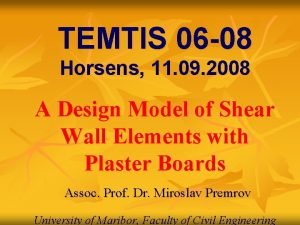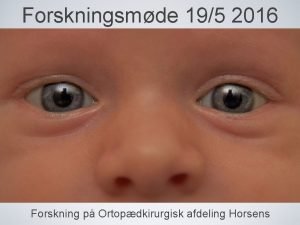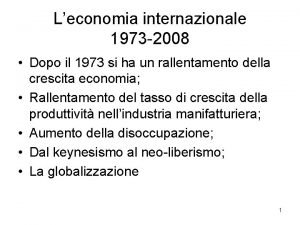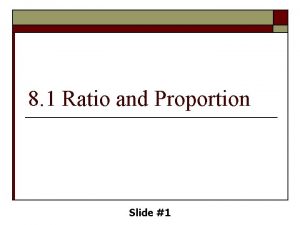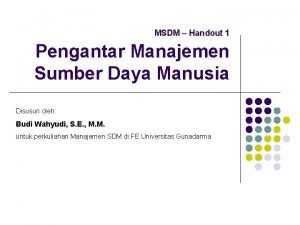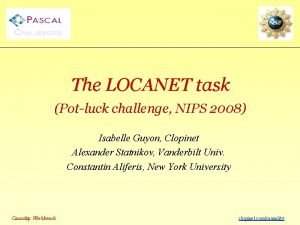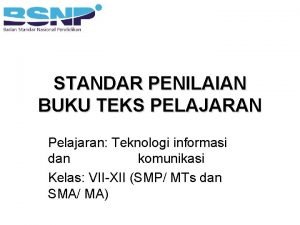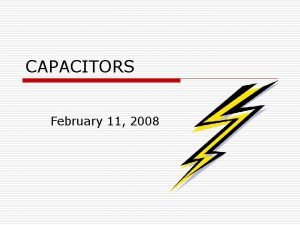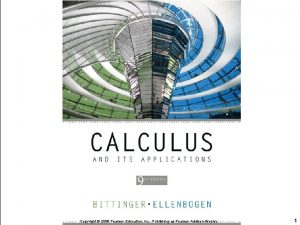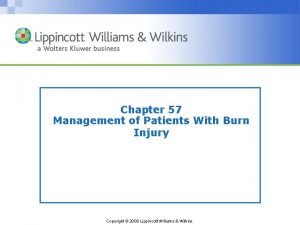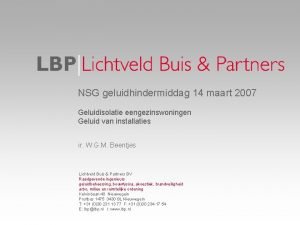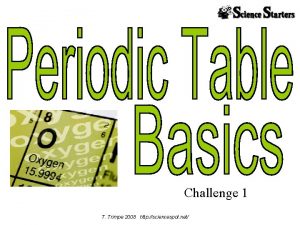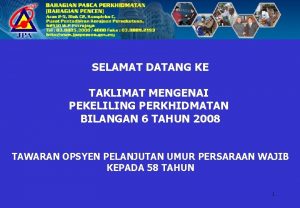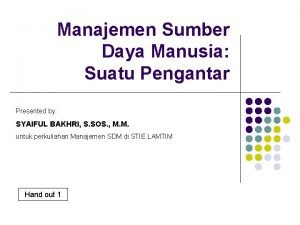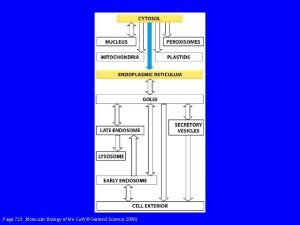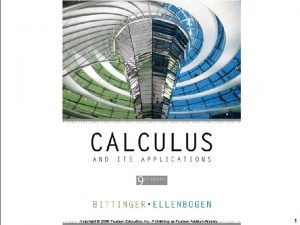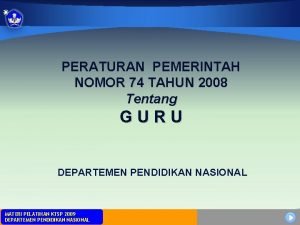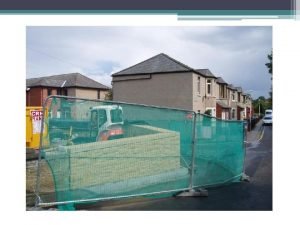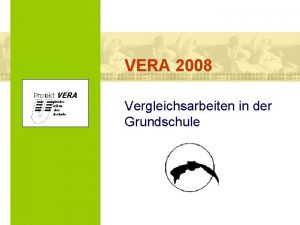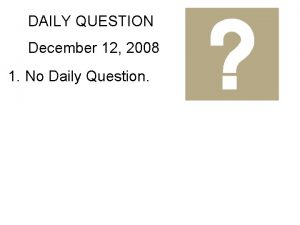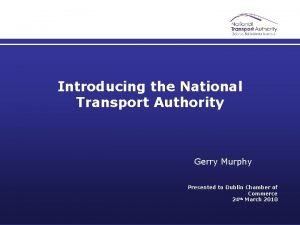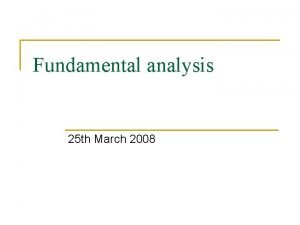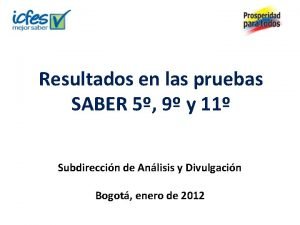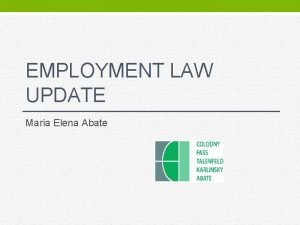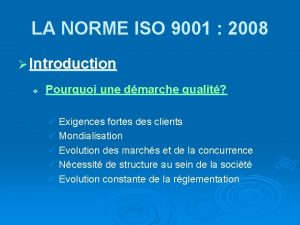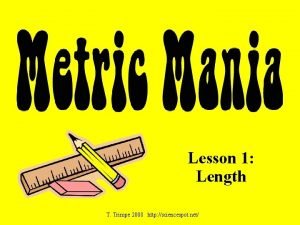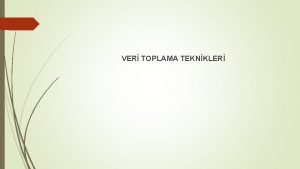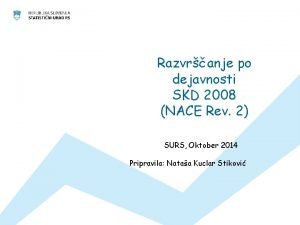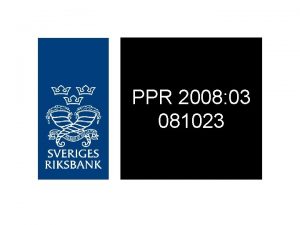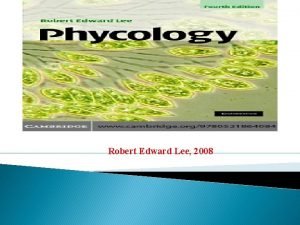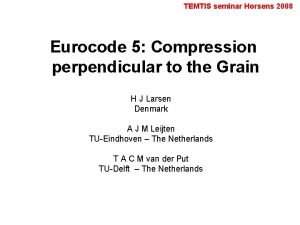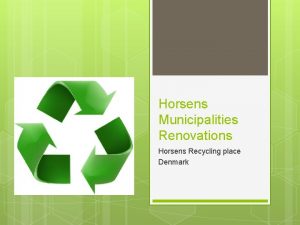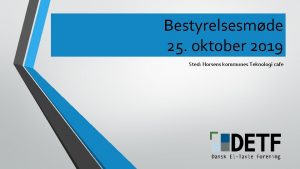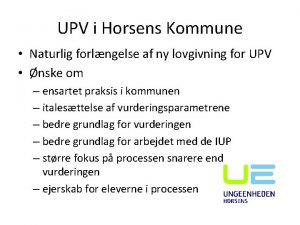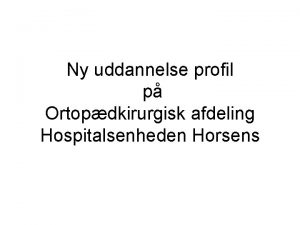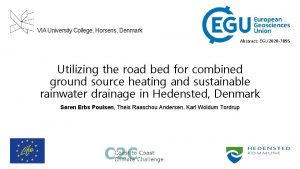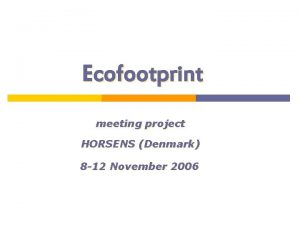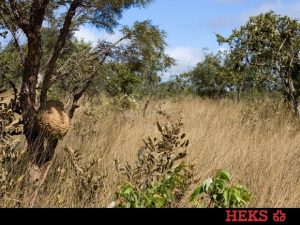TEMTIS 06 08 Horsens 11 09 2008 A













![Comparison of the Measured Vertical Displacements F [k. N] v [mm] unreinforced Comparison of the Measured Vertical Displacements F [k. N] v [mm] unreinforced](https://slidetodoc.com/presentation_image_h/13672f78e2c544929d581d00618598c6/image-14.jpg)











































![FH [k. N] F 1(FPB) [N] F 1(WBB) [N] ΔFPB [mm] ΔWBB [mm] 5. FH [k. N] F 1(FPB) [N] F 1(WBB) [N] ΔFPB [mm] ΔWBB [mm] 5.](https://slidetodoc.com/presentation_image_h/13672f78e2c544929d581d00618598c6/image-58.jpg)




![The stiffness coefficient of the fasteners (γy) is computed using EC 5[3] The stiffness coefficient of the fasteners (γy) is computed using EC 5[3]](https://slidetodoc.com/presentation_image_h/13672f78e2c544929d581d00618598c6/image-63.jpg)



- Slides: 66

TEMTIS 06 -08 Horsens, 11. 09. 2008 A Design Model of Shear Wall Elements with Plaster Boards Assoc. Prof. Dr. Miroslav Premrov University of Maribor, Faculty of Civil Engineering

1. Current Tendency in Timber Building in the World · · · Tendency to multi-story prefabricated timber-frame houses. At least F + 3 It is important to assure beside fire resistance also a construction resistance stability.

Different Systems in Multi-Story Building a. ) Platform Building b. ) Balloon System c. ) Massive System Frame System Space Frame System Multi-layer Panels Macro-panel System

2. Timber-Framed Wall System 2. 1. Static Design · Although timber-framed walls are meantime connected they can be in static design considered as separated cantilever elements (Eurocode 5 -1 -1).


2. 2. Composition of Timber. Framed Walls - timber frame, - fibreboards (as sheathing boards) - fiber-plaster boards, - plaster-cardboards, - OSB (Oriented Standard Board, North America, . . )

timber frame boards Composition of a Timber Panel Shear Wall


3. Strengthening of FPB n Ussing additional fibre-plaster boards (FPB) – very popular by producers n n By reinforcing with classical steel diagonals in the tensile area of FPB By reinforcing with carbon or high-strength syntetic fibres in the tensile area of FPB

3. 1. Additional Boards The simplest case of reinforcing. Usually used by producers. Boards can be added: - symmetric, - asymmetric. Resistance of boards is increased, but ductility is practically not changed.

What was increased? The force forming the first crack for 35, 82%. The crack extended by only for 9% bigger force to the internal board. Destruction force for 25, 65%. What was decreased? “Ductility” for 7, 41%

3. 2. Reinforcing with Steel Diagonal Elements Static System of the Test Samples

Destruction force unreinforced: 20, 18 k. N; reinforced: 35, 73 k. N ratio = 1. 77 Ductility was increased for 39, 64%!
![Comparison of the Measured Vertical Displacements F k N v mm unreinforced Comparison of the Measured Vertical Displacements F [k. N] v [mm] unreinforced](https://slidetodoc.com/presentation_image_h/13672f78e2c544929d581d00618598c6/image-14.jpg)
Comparison of the Measured Vertical Displacements F [k. N] v [mm] unreinforced

Hotel Terme Zreče (3+M)

3. 3. Reinforcing with CFRP Diagonal Strips

3. 3. 1. Test Configuration 1. The first group (G 1) of three test samples was additionally reinforced with two CFRP diagonal strips (one in each FPB) of width 300 mm which were glued on the FPB using Sikadur-330 LVP. The strips were additionally glued to the timber frame to ensure the transmission of the force from FPB to the timber frame.


2. The second group (G 2) of three test samples was additionally reinforced with two CFRP diagonal strips of width 600 mm. The strips were glued on FPB and to the timber frame as in G 1. 3. The third group (G 3) of three test samples was additionally reinforced with two CFRP diagonal strips of width 300 mm as in G 1 but they were not glued to the timber frame.


Properties of the used materials E 0, m Gm fm, k ft, 0, k fc, 0, k fv, k ρm [N/mm 2] [N/mm 2] [kg/m 3] Timber C 22 10000 630 22 13 20 2. 4 410 Fibre-plaster board 3000 1200 4. 0 2. 5 20 5. 0 1050 231000 / / 4100 / / 1920 Sika. Wrap 230 C

3. 3. 2. Test Results Average force forming the first crack in FPB unreinforced: 17. 67 k. N G 1: 24, 28 k. N G 2: 32, 13 k. N G 3: 35, 90 k. N

Average destruction force unreinforced: 26, 02 k. N G 1: 40, 33 k. N G 2: 46, 27 k. N G 3: 36, 26 k. N

Test samples behaviour Further information on the behaviour of tested elements can be obtained by calculation of the "safety " (ci) and "ductility coefficients of FPB" (di) in the following forms:

Measured bending deflections under the force F (mm) un-strengthened samples G 1 samples G 2 samples G 3

It is evident from figure that, similarly to the classical reinforcement with BMF steel diagonals presented in Dobrila and Premrov (2003), there is practically no influence on stiffness of any reinforcement before appearance of cracks in the un-strengthened FPB. This is logical because in this case the reinforcement is practically not activated at all and its stiffness in comparison to the stiffness of un-cracked FPB is small. After appearance of the first crack in the un-strengthened test samples (Fcr, uns = 17. 67 k. N) the influence of the CFRP strips is obvious and it depends on the strip’s dimensions as well as on the boundary conditions between the strips and the timber frame.

Measured average slips in the connecting area (mm) samples G 1 samples G 2 samples G 3

Conclusions for G 1 and G 2 test groups Beside the fact that samples G 1 and especially G 2 demonstrated higher load-carrying capacity than samples G 3, it is important to mention that samples G 1 and G 2 produced substantially smaller slip than samples G 3, which never exceeded 1 mm at the first crack forming. Therefore it can be assumed that the yield point of the fasteners was not achieved before cracks appeared at all! Consequently, the walls tend to fail because of the crack forming in FPB. In this case of strengthening the ductility of the whole wall element (see Fig. 6 for samples G 1 and G 2) practically coincides with the “ductility” of FPB, as proposed with d 1 and d 2 coefficients.

Conclusions for G 3 test group In contrast, in G 3 model, where the CFRP strips were unconnected to the timber frame, the slip (Δ) between the FPB and the timber frame was evidently higher than in samples G 1 and G 2, and exceeded 3 mm when the first crack in FPB appeared. The load-displacement relation (F-Δ) of the fasteners was in this case at the force which produced first cracks almost completely plastic. Since the tensile strength of FPB is essentially improved, the walls tend to fail because of fastener yielding. Although the fibreboards in samples G 3 demonstrated practically no deformation capacity (d 3 ≈ 1. 0, Eq. 14) the ductility is formed (F-w diagram) over the fasteners yielding.

4. Design Models n n Shear model (EC 5) Composite Beam Model

4. 1. Modelling of walls with wood -based sheathing boards Shear Model (EC 5)

«Lower bound plastic method « Källsner and Lam (1995) a. ) behaviour of the joints between the sheet and the frame members is assumed to be linear-elastic until failure, b. ) the frame members and the sheets are assumed to be rigid and hinged to each other.

Shear resistance - Method A Shear resistance - Method B

4. 2. Modelling of walls with fibre - plaster sheathing boards Composite Beam Model

4. 2. 1. » γ-method « (EC 5) Basic assumptions: n n n Bernoulli`s hypothesis is valid for each subcomponent, slip stiffness is constant along the element, material behaviour of all sub-components is linear elastic.

Effective bending stiffness (EIy)eff of mechanically jointed beams

4. 2. 2. Influnce of steel (CFPR) diagonal reinforcing

Shear deformation in one fiberboard is: Horizontal displacement of the fiberboard is: Axial force in the tensile steel diagonal is:

Horizontal displacement of the tensile steel diagonal is thus: If we consider continuity of horizontal displacements ub = us, we get for the total cross section of the fictive fiberboard:

Proposed Models: Model with the fictive thickness of the board: Model with the fictive width of the board:

a. ) Normal panel (without reinforcement) b. ) Panel with the fictive width c. ) Panel with the fictive thickness

4. 2. 3. Modelling of fasteners flexibility

Definition of slip modulus K

4. 1. 4. Modelling of cracks in FPB Force forming the first crack in FPB:

Major assumptions of the cracked cross-section: n n The tensile area of the fibreboards is neglected after the first crack formation. The stiffness coefficient of the fasteners in the tensile connecting area (γyt) is assumed to be constant and equal to the value by appearing the first crack. The stiffness coefficient of the fasteners in the compressed connecting area (γyc) is not constant and depends on the lateral force acting on one fastener. The normal stress distribution is assumed to be linear. This simplification can be used only by assumption that behaviour of timber frame in tension is almost elastic until failure and that the compressive normal stress in timber and in FPB is under the belonging yield point.


Characteristic horizontal destruction force (according to the tensile stress in the timber stud)

5. Numerical Example 5. 1 Geometrical and material properties

n Height of the wall: h = 263. 5 cm Staples: Φ 1. 53 mm, length l = 35 mm, constant spacing s = 75 mm n

Timber C 22 FPB Knauf Swedian (S) Plywood* 10000 3000 9200 fm, k [N/mm 2] 22. 0 4. 0 23. 0 ft, 0, k [N/mm 2] 13. 0 2. 5 15. 0 fc, 0, k [N/mm 2] 20. 0 15. 0 ρk [kg/m 3] 340 1050 410 ρm [kg/m 3] 410 1050 410 E 0, m [N/mm 2] * The values are given for 12 mm typical thickness of the board.

5. 2 Results a. ) Lateral load-bearing capacity of the staples (Johansen expressions): n n FPB: Ff, Rk = 659. 69 N Ff, Rd = 456. 71 N WBB (plywood): Ff, Rk = 516. 74 N Ff, Rd = 357. 74 N

b. ) Slip modulus (Kser) of the staples: FPB:

WBB:

c. ) Stiffness coefficient γyi before any cracks appearing in the boards (Composite model):

d. ) Effective bending stiffness (EIy)eff of the uncracked cross-section (Composite model):

e. ) Horizontal force (FH, cr) forming the first tensile crack in board (Composite model):

f. ) Characteristic horizontal load-carrying capacity (FH, k): FPB (Composite model, timber condition): FPB (Shear model, fastener‘s yielding criteria) WBB (Shear model, fastener‘s yielding criteria)
![FH k N F 1FPB N F 1WBB N ΔFPB mm ΔWBB mm 5 FH [k. N] F 1(FPB) [N] F 1(WBB) [N] ΔFPB [mm] ΔWBB [mm] 5.](https://slidetodoc.com/presentation_image_h/13672f78e2c544929d581d00618598c6/image-58.jpg)
FH [k. N] F 1(FPB) [N] F 1(WBB) [N] ΔFPB [mm] ΔWBB [mm] 5. 0 69. 289 19. 279 0. 235 0. 132 10. 0 138. 579 38. 558 0. 469 0. 264 13. 53 = F(FPB)H, cr 187. 497 < Nal 52. 170 0. 635 0. 358 15. 0 198. 189 57. 838 0. 671 0. 397 20. 0 258. 064 77. 117 0. 922 0. 529 25. 0 306. 057 96. 396 1. 224 0. 661 30. 0 352. 426 115. 674 1. 532 0. 792 35. 0 394. 036 134. 953 1. 859 0. 924 39. 58 = F(FPB)H, k 437. 011 < Ff, Rd 152. 613 2. 138 1. 045 / 202. 12 ≈ Nal / 1. 384 52. 42 = F(WBB)H, cr

Conclusions n FPB Shear model (EC 5) is not recommended! Practical use Reinforcing of FPB by multi-storey buildings (steel diagonals, CFRP diagonals)

Experimental results for FPB n n P. Dobrila, M. Premrov, Reinforcing Methods for Composite Timber Frame – Fibreboard Wall Panels. Engineering Structures, Vol. 25, No. 11, 2003, pp. 1369 -1376. M. Premrov, P. Dobrila, B. S. Bedenik, Analysis of timber-framed walls coated with CFRP strips strengthened fibre-plaster boards, International Journal of Solids and Structures, Vol. 41, No. 24/25, 2004, pp. 7035– 7048.

n WBB Shear model (EC 5) is recommended! Practical use No need of any board´s reinforcing, decreasing of fastener´s spacing

6. Numerical Example for G 1 CFRP Test Sample Fasteners slip modulus (Kser) can be computed using Eurocode 5: n
![The stiffness coefficient of the fasteners γy is computed using EC 53 The stiffness coefficient of the fasteners (γy) is computed using EC 5[3]](https://slidetodoc.com/presentation_image_h/13672f78e2c544929d581d00618598c6/image-63.jpg)
The stiffness coefficient of the fasteners (γy) is computed using EC 5[3]

The horizontal force (FH, cr) forming the first tensile crack in FPB is: measured: FH, cr, meas = 24. 28 k. N

The crushing horizontal force (FH, u): Numerical: FH, u = 42. 68 k. N measured: FH, u = 40. 33 k. N

7. Conclusions WBB → Shear (EC 5 ) model Fasteners yielding appear before cracks forming in the tensile area of boards. n FBP → Composite model It was presented that by forming first tensile craks in boards stresses in fasteners are tolerably under the yield points. n
 Temtis
Temtis Handelsassistent
Handelsassistent Produktionsteknologi horsens
Produktionsteknologi horsens Ortopædkirurgisk afdeling horsens
Ortopædkirurgisk afdeling horsens 2008 2008
2008 2008 2008-1973
2008-1973 June 20 2008
June 20 2008 Lingkungan msdm (mondy 2008)
Lingkungan msdm (mondy 2008) From [email protected] sat jan 5 09:14:16 2008
From [email protected] sat jan 5 09:14:16 2008 What does white represent
What does white represent Garland science 2008
Garland science 2008 Kielhofner 2008
Kielhofner 2008 Gbob stands for
Gbob stands for The hurt locker 2008
The hurt locker 2008 Penyajian hasil penilaian sebuah buku dalam bentuk
Penyajian hasil penilaian sebuah buku dalam bentuk February 11 2008 calendar
February 11 2008 calendar Perda no 2 tahun 2008
Perda no 2 tahun 2008 2008 pearson education inc
2008 pearson education inc Lippincott williams & wilkins
Lippincott williams & wilkins Giw/isso 2008
Giw/isso 2008 Vivado vhdl 2008
Vivado vhdl 2008 Halide with 6 energy levels
Halide with 6 energy levels Quicken 2008
Quicken 2008 Ita 2008
Ita 2008 Gegensätzliche charaktereigenschaften
Gegensätzliche charaktereigenschaften 22 mai 2008
22 mai 2008 Ms sql 2008 dts
Ms sql 2008 dts Microsoft robotics studio
Microsoft robotics studio Beijing olympics 2008
Beijing olympics 2008 2008
2008 Borang opsyen pencen 2008
Borang opsyen pencen 2008 Fungsi msdm menurut mondy 2008
Fungsi msdm menurut mondy 2008 Riboforina
Riboforina 2008 pearson education inc
2008 pearson education inc Pearson education limited 2008
Pearson education limited 2008 Pp nomor 74 tahun 2008
Pp nomor 74 tahun 2008 Morpeth floods 2008
Morpeth floods 2008 Uk 2008
Uk 2008 Gascornedo
Gascornedo Fungsi msdm menurut mondy 2008
Fungsi msdm menurut mondy 2008 Projekt vera 3
Projekt vera 3 Xxxxx me
Xxxxx me O ano de 2008 assinala os duzentos anos da chegada
O ano de 2008 assinala os duzentos anos da chegada Medaljer os 2012
Medaljer os 2012 December 12 2008
December 12 2008 Dublin transport authority act 2008
Dublin transport authority act 2008 Computers from 2008
Computers from 2008 Copyright 2008
Copyright 2008 25 march 2008
25 march 2008 Resultados icfes 2008
Resultados icfes 2008 Adaaa 2008
Adaaa 2008 11356
11356 Norme iso 9001 2008
Norme iso 9001 2008 Fungsi desain form
Fungsi desain form Iso 9001:2008 certification in mumbai
Iso 9001:2008 certification in mumbai T. trimpe 2008 http://sciencespot.net/
T. trimpe 2008 http://sciencespot.net/ Proposta razoável para indemnização do dano corporal
Proposta razoável para indemnização do dano corporal 1957-2008
1957-2008 Görüşme türleri
Görüşme türleri Stamp duty(amendment) proclamation no. 612/2008
Stamp duty(amendment) proclamation no. 612/2008 Klasifikacija cpa/skd
Klasifikacija cpa/skd Ppr 2008 english
Ppr 2008 english Pyrrophyta algae
Pyrrophyta algae Www middleschoolscience com 2008
Www middleschoolscience com 2008 Health and safety social care act 2008
Health and safety social care act 2008 Ms sql security best practices
Ms sql security best practices March 7 2008
March 7 2008
